THE WORLD BIRDS - An Online Bird Book
QUAIL THRUSHes and more
Order Passeriformes Family Cinclosomatidae
QUAIL THRUSHes and more
Order Passeriformes Family Cinclosomatidae
The Australasian family Cinclosomatidae contains the quail-thrushes and jewel-babblers. This is a different family from either quails or thrushes, but quail-thrushes bare a superficial resemblance to these other birds. The quail-thrushes are largely brown above, the colur varying to provide camouflage against the soil, but are more boldly marked with black and white below. They are terrestrial birds which fly fairly weakly and prefer to squat or run when disturbed. They forage on the ground feeding mainly on insects and other invertebrates.
Some include the quail-thrushes and jewel-babblers in family Psophodidae. Here family Psophodidae only contrains the whipbirds and wedgebills.
Genus Cinclosoma
Found: Austrail and New Guinea
Quail-thrush,_Chestnut also Chestnut-backed Quail-Thrush Cinclosoma castanotum Found: Australia
Image by: 1) Pinned 2) David Cook - South Australia 3) Kevin1243 - Gluepot Reserve 4) Peter_Jacobs 5) Brian_McCauley
1, 2, 3) Female 4, 5) Male

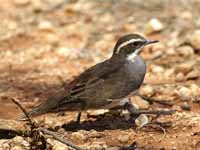

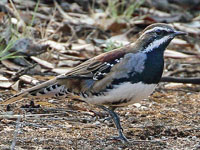
Quail-thrush,_Chestnut-breasted Cinclosoma castaneothorax Found: Australia
Image by: 1) Pinned 2) David Cook 3) Jeremy Ringma 4) Tom Tarrant




Quail-thrush,_Cinnamon Cinclosoma cinnamomeum Found: Australia
The male Cinnamon Quail-Thrush has cinnamon-rufous upperparts; pale underparts with black breast band; white supercilium; black eye-line; black throat with broad white border on sides. Female similar with little black.
Image by:
1) David Cook 2) Ron Knight - South Australia 3) Brian_McCauley1) Female 2, 3) Male



Quail-thrush,_Copperback Cinclosoma clarum Found: Austraila
The Copperback Quail-thrush was split formerly a subspecies of the Chestnut Quail-thrush.
Image by: 1) Rob_Morris
Quail-thrush,_Nullarbor Cinclosoma alisteri Found: Austrailia
The Nullarbor Quail-thrush is the only Australian bird endemic to the Nullarbor Plain in southern Australia
Image by: 1) Russell_Scott
Quail-thrush, Painted Cinclosoma ajax Found: New Guinea
The male Painted Quail-thrush has rusty-brown upperparts; black lores to side of neck; black chin, center of throat, upper-breast; white belly, under-tail coverts; black bill; pinkish legs. Female smaller than male; olive-brown upperparts, crown; dark brown side of head; whitish supercilium; rufous-brown upper-breast; off-white rest of underparts.
Image by: 1) Katerina_Tvardikova 2) Nicholas Le Jeune 3) Elrina7532) Female 3) Male



Quail-thrush, Spotted Cinclosoma punctatum Found: Australia
Image by: 1) Oystercatcher 2) Aviceda - SE Queensland 3) Lip Kee - Victoria
1) Female 2, 3) Male



Quail-thrush,_Westeren Cinclosoma marginatum Found: Australia
Image by: 1) Russell_Cumming

Genus Ptilorrhoa
Found: New Guinea
The jewel-babblers resemble the quail-thrushes in shape, being plump, long-tailed and short winged. They are adapted to life on the forest floor. The plumage of this genus is the most striking divergence from the quail-thrushes, having large amounts of blue and often with chestnut on the back. The throats of all species are white and the patch is mostly surrounded by a black edge.
Jewel-Babbler_ Blue Ptilorrhoa caerulescens Found: New Guinea.
Image by: 1, 3) Katerina_Tvardikova 2) Nicholas Le Jeune



Jewel-Babbler,_Chestnut-backed Ptilorrhoa castanonota Found: New Guinea
Image by: 1) Katerina_Tvardikova 2) Pinned


Jewel-Babbler, Spotted Ptilorrhoa leucosticta Found: New Guinea.
Image by: 1, 3) Katerina_Tvardikova 2) Joseph Smit 4) Chien Lee


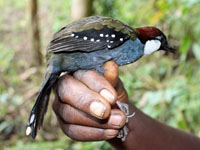

Whipbirds and wedgebills are 19–31 cm long. They are mainly olive-green or brown in colour and have a crest, They are sometimes included in family Cinclosomatidae.
Genus Androphobus - 1 species
Whipbird,_Papaun Androphobus viridis Found: New Guinea
Image by: 1) hbw.com 2) Pinned 3) Pinned



Genus Psophodes
Found: Australia
Wedgebill,_Chiming Psophodes occidentalis Found: Australia
Image by: 1) Chocolateoak 2) Sunphlo 3, 4) Brian_McCauley




Wedgebill,_Chirruping Psophodes cristatus Found: Australia
Image by: 1) Peter_Jacobs 2, 3) Dave_Curtis



Whipbird,_Eastern Psophodes olivaceus Found: Australia
The Eastern Whipbird has dark green plumage; white cheek patch.
Image by: 1, 2) David Cook - Broulee,
NSW, Australia 3) Greg_Miles1) Juvenile
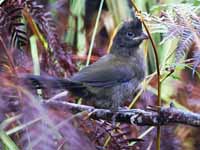


Whipbird,_Western Psophodes nigrogularis Found: southern Australia
The Western Whipbird has olive-green upperparts; black throat; white cheek stripe; pale olive-green underparts.
Image by: 1) Laurie_Boyle 2) Steve_Elson 3) Brian_McCauley 4) steintil2012 



The Bristlebirds, of family Dasyornithidae, are found in Australia, This family contains only one genus. These birds were originally placed in the same family as the Peep-wrens of family Pardalotidae. They are usually found on the ground and only fly for small distances.
Genus Dasyornis
Bristlebird, Eastern Dasyornis brachypterus Found: Australia
Image by: 1, 2) David Cook


Bristlebird,_Rufous Dasyornis broadbentis Found: Australia
Image by: 1, 2) sunphlo - victoria 3) Matt_Francey



Bristlebird, Western Dasyornis longirostris Found: Australia
The Western Bristlebird rufous upperparts with dark brown under surface feathers yielding scalloped look; off-white neck, face; red eyes.
Image by: 1) Ray Wilson 2) jacksnipe1990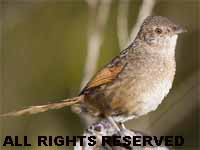

Order Passeriformes Family Orthonychidae
The family Orthonychidae contains the logrunners. They are found in Australasia. The spend most of their life on near the ground and thus have evolved to have poor flighj. Similar to woodpeckers, they stiffen their tails while feeding. In the case of logrunners, the use their spiny tail for support while digging in the soil.
Genus Orthonyx
Chowchilla Orthonyx spaldingii Found: Australia
The Chowchilla has dark-brown upperparts, head; white eye-ring. Male has white throat, underparts. Female has rufous throat, upper-breast; white lower-breast, belly.
Image by: 1, 2) Dave Curtis1, 2) Female


Logrunner, Australian Orthonyx temminckii Found: Australia
Image by: 1) Aviceda - Lamington NP, SE Queensland, Australia 2, 3) David Cook - Springbrook National Park, Queensland, Australia
1, 2) Male 3) Female



Logrunner, Papuan Orthonyx novaeguineae Found: New Guinea
The Papuan Logrunner has dark brown upperparts; gray head with dark rufous-brown crown; black upper-wing coverts; 2 white wing-bars; white chin, throat, underparts; gray flanks; black legs.
Image by: 1) Katerina_Tvardikova 2) hbw.com

The Pardalotes have only one genus. They are very small, brightly coloured birds native to Australia, with short tails, strong legs, and stubby blunt beaks.These birds were originally placed in the same family as the flowerpeckers because of similar shape and bright coloring. However, DNA evidence now indicates they are unrelated. The Peep-Wrens are related to the members of the Acanthizidae family, Both families are found in Australasia.
Genus Pardalotus
Pardalote, Forty Spotted Pardalotus quadragintus Found: Tasmania
The Forty-spotted Pardalote has greenish-brown upperparts, head; olive rump;dull yellow under-tail; white breast with yellowish tints; black wings with white tips.
Image by: 1) Nomdeplumb - Maria Island, off the coast of Tasmania 2) David
Cook 3) Dave Curtis


Pardalote,_Red-browed Pardalotus rubricatus Found: Australia
The Red-browed Pardalote has black crown with white spots; yellow to buff supercilium; reddish brow; yellow breast patch, wing patches.
Image by: 1) Ron_Knight 2, 4) Graham_Winterflood 3) Brian_McCauley



Pardalote, Spotted Pardalotus punctatus Found: Australia
The Sp0tted Pardalote has dark upperparts with white spots over most of upperparts. They always nest in tunnels. Those birds with yellow rumps are a subspecies called the Yellow-rumped Pardalote.
Image by: 1, 3) JJ
Harrison - Tasmania 2, 5) David
Cook - NSW, Australia 4) Arthur Chapman 6) Brian_McCauley1, 2, 3) Female 4, 5, 6) Male
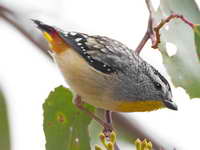



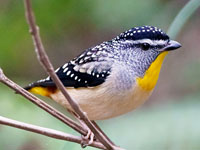

Pardalote,_Striated Pardalotus striatus Found: Australia
The Striated Pardalote has olive upperparts; black crown and most subspecies have white streaks on the crown; white eyebrow with yellow spot near the bill.
Image by: 1) birdsaspoetry 2, 3) Laurie_Boyle 4) fir2000 5) Nik_Borrow



